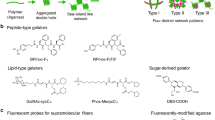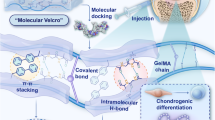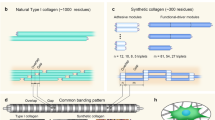Abstract
Replicating the multi-hierarchical self-assembly of collagen has long-attracted scientists, from both the perspective of the fundamental science of supramolecular chemistry and that of potential biomedical applications in tissue engineering. Many approaches to drive the self-assembly of synthetic systems through the same steps as those of natural collagen (peptide chain to triple helix to nanofibres and, finally, to a hydrogel) are partially successful, but none simultaneously demonstrate all the levels of structural assembly. Here we describe a peptide that replicates the self-assembly of collagen through each of these steps. The peptide features collagen's characteristic proline–hydroxyproline–glycine repeating unit, complemented by designed salt-bridged hydrogen bonds between lysine and aspartate to stabilize the triple helix in a sticky-ended assembly. This assembly is propagated into nanofibres with characteristic triple helical packing and lengths with a lower bound of several hundred nanometres. These nanofibres form a hydrogel that is degraded by collagenase at a similar rate to that of natural collagen.
This is a preview of subscription content, access via your institution
Access options
Subscribe to this journal
Receive 12 print issues and online access
$259.00 per year
only $21.58 per issue
Buy this article
- Purchase on Springer Link
- Instant access to full article PDF
Prices may be subject to local taxes which are calculated during checkout






Similar content being viewed by others
References
Ottani, V., Martini, D., Franchi, M., Ruggeri, A. & Raspanti, M. Hierarchical structures in fibrillar collagens. Micron 33, 587–596 (2002).
Ottani, V., Raspanti, M. & Ruggeri, A. Collagen structure and functional implications. Micron 32, 251–260 (2001).
Pinkas, D. M., Ding, S., Raines, R. T. & Barron, A. E. Tunable, post-translational hydroxylation of collagen domains in Escherichia coli. ACS Chem. Biol. 6, 320–324 (2011).
Buechter, D. D. et al. Co-translational incorporation of trans-4-hydroxyproline into recombinant proteins in bacteria. J. Biol. Chem. 278, 645–650 (2003).
Kohrer, C., Xie, L., Kellerer, S., Varshney, U. & Rajbhandary, U. L. Import of amber and ochre suppressor tRNAs into mammalian cells: a general approach to site-specific insertion of amino acid analogues into proteins. Proc. Natl Acad. Sci. USA 98, 14310–14315 (2001).
Liu, D. R., Magliery, T. J., Pasternak, M. & Schultz, P. G. Engineering a tRNA and aminoacyl–tRNA synthetase for the site-specific incorporation of unnatural amino acids into proteins in vivo. Proc. Natl Acad. Sci. USA 94, 10092–10097 (1997).
Liu, D. R. & Schultz, P. G. Progress toward the evolution of an organism with an expanded genetic code. Proc. Natl Acad. Sci. USA 96, 4780–4785 (1999).
Mendel, D., Cornish, V. W. & Schultz, P. G. Site-directed mutagenesis with an expanded genetic-code. Annu. Rev. Biophys. Biomol. Struct. 24, 435–462 (1995).
Boudko, S. P. et al. Crystal structure of human type III collagen Gly991-Gly1032 cystine knot-containing peptide shows both 7/2 and 10/3 triple helical symmetries. J. Biol. Chem. 283, 32580–32589 (2008).
Kar, K. et al. Aromatic interactions promote self-association of collagen triple-helical peptides to higher-order structures. Biochemistry 48, 7959–7968 (2009).
Kramer, R. Z., Bella, J., Brodsky, B. & Berman, H. M. The crystal and molecular structure of a collagen-like peptide with a biologically relevant sequence. J. Mol. Biol. 311, 131–147 (2001).
Krishna, O. D. & Kiick, K. L. Supramolecular assembly of electrostatically stabilized, hydroxyproline-lacking collagen-mimetic peptides. Biomacromolecules 10, 2626–2631 (2009).
Persikov, A. V., Ramshaw, J. A., Kirkpatrick, A. & Brodsky, B. Amino acid propensities for the collagen triple-helix. Biochemistry 39, 14960–14967 (2000).
Persikov, A. V., Ramshaw, J. A. M., Kirkpatrick, A. & Brodsky, B. Electrostatic interactions involving lysine make major contributions to collagen triple-helix stability. Biochemistry 44, 1414–1422 (2005).
Sakakibara, S. et al. Synthesis of (Pro-Hyp-Gly)n of defined molecular-weights – evidence for stabilization of collagen triple helix by hydroxyproline. Biochim. Biophys. Acta 303, 198–202 (1973).
Shah, N. K., Ramshaw, J. A., Kirkpatrick, A., Shah, C. & Brodsky, B. A host–guest set of triple-helical peptides: stability of Gly-X-Y triplets containing common nonpolar residues. Biochemistry 35, 10262–10268 (1996).
Venugopal, M. G., Ramshaw, J. A., Braswell, E., Zhu, D. & Brodsky, B. Electrostatic interactions in collagen-like triple-helical peptides. Biochemistry 33, 7948–7956 (1994).
Fallas, J. A., Gauba, V. & Hartgerink, J. D. Solution structure of an ABC collagen heterotrimer reveals a single-register helix stabilized by electrostatic interactions. J. Biol. Chem. 284, 26851–26859 (2009).
Gauba, V. & Hartgerink, J. D. Self-assembled heterotrimeric collagen triple helices directed through electrostatic interactions. J. Am. Chem. Soc. 129, 2683–2690 (2007).
Gauba, V. & Hartgerink, J. D. Surprisingly high stability of collagen ABC heterotrimer: evaluation of side chain charge pairs. J. Am. Chem. Soc. 129, 15034–15041 (2007).
Gauba, V. & Hartgerink, J. D. Synthetic collagen heterotrimers: structural mimics of wild type and mutant collagen type I. J. Am. Chem. Soc. 130, 7509–7515 (2008).
Madhan, B., Xiao, J. X., Thiagarajan, G., Baum, J. & Brodsky, B. NMR monitoring of chain-specific stability in heterotrimeric collagen peptides. J. Am. Chem. Soc. 130, 13520–13521 (2008).
Ottl, J. et al. Design and synthesis of heterotrimeric collagen peptides with a built-in cystine-knot. Models for collagen catabolism by matrix-metalloproteases. FEBS Lett. 398, 31–36 (1996).
Russell, L. E., Fallas, J. A. & Hartgerink, J. D. Selective assembly of a high stability AAB collagen heterotrimer. J. Am. Chem. Soc. 132, 3242–3243 (2010).
Cejas, M. A. et al. Thrombogenic collagen-mimetic peptides: self-assembly of triple helix-based fibrils driven by hydrophobic interactions. Proc. Natl Acad. Sci. USA 105, 8513–8518 (2008).
Kar, K. et al. Self-association of collagen triple helix peptides into higher order structures. J. Biol. Chem. 281, 33283–33290 (2006).
Kar, K., Wang, Y. H. & Brodsky, B. Sequence dependence of kinetics and morphology of collagen model peptide self-assembly into higher order structures. Protein Sci. 17, 1086–1095 (2008).
Kotch, F. W. & Raines, R. T. Self-assembly of synthetic collagen triple helices. Proc. Natl Acad. Sci. USA 103, 3028–3033 (2006).
Paramonov, S. E., Gauba, V. & Hartgerink, J. D. Synthesis of collagen-like peptide polymers by native chemical ligation. Macromolecules 38, 7555–7561 (2005).
Yamazaki, C. M., Asada, S., Kitagawa, K. & Koide, T. Artificial collagen gels via self-assembly of de novo designed peptides. Biopolymers 90, 816–823 (2008).
Skrzeszewska, P. J. et al. Physical gels of telechelic triblock copolymers with precisely defined junction multiplicity. Soft Matter 5, 2057–2062 (2009).
Rele, S. et al. D-periodic collagen-mimetic microfibers. J. Am. Chem. Soc. 129, 14780–14787 (2007).
Banwell, E. F. et al. Rational design and application of responsive alpha-helical peptide hydrogels. Nature Mater. 8, 596–600 (2009).
Yang, Y. L., Leone, L. M. & Kaufman, L. J. Elastic moduli of collagen gels can be predicted from two-dimensional confocal microscopy. Biophys. J. 97, 2051–2060 (2009).
Mi, K. et al. Influence of a self-assembling peptide, RADA16, compared with collagen I and Matrigel on the malignant phenotype of human breast cancer cells in 3D cultures and in vivo. Macromol. Biosci. 9, 437–443 (2009).
Greenfield, M. A., Hoffman, J. R., de la Cruz, M. O. & Stupp, S. I. Tunable mechanics of peptide nanofiber gels. Langmuir 26, 3641–3647 (2010).
Yokoi, H., Kinoshita, T. & Zhang, S. Dynamic reassembly of peptide RADA16 nanofiber scaffold. Proc. Natl Acad. Sci. USA 102, 8414–8419 (2005).
Zhang, S. G. et al. Self-complementary oligopeptide matrices support mammalian-cell attachment. Biomaterials 16, 1385–1393 (1995).
Lamm, M. S., Rajagopal, K., Schneider, J. P. & Pochan, D. J. Laminated morphology of nontwisting beta-sheet fibrils constructed via peptide self-assembly. J. Am. Chem. Soc. 127, 16692–16700 (2005).
Ozbas, B., Kretsinger, J., Rajagopal, K., Schneider, J. P. & Pochan, D. J. Salt-triggered peptide folding and consequent self-assembly into hydrogels with tunable modulus. Macromolecules 37, 7331–7337 (2004).
Aulisa, L., Dong, H. & Hartgerink, J. D. Self-assembly of multidomain peptides: sequence variation allows control over cross-linking and viscoelasticity. Biomacromolecules 10, 2694–2698 (2009).
Ottl, J. et al. Recognition and catabolism of synthetic heterotrimeric collagen peptides by matrix metalloproteinases. Chem. Biol. 7, 119–132 (2000).
Serpell, L. C., Fraser, P. E. & Sunde, M. X-ray fiber diffraction of amyloid fibrils. Methods Enzymol. 309, 526–536 (1999).
Okuyama, K. Revisiting the molecular structure of collagen. Connect. Tissue Res. 49, 299–310 (2008).
Pandya, M. J. et al. Sticky-end assembly of a designed peptide fiber provides insight into protein fibrillogenesis. Biochemistry 39, 8728–8734 (2000).
Woolfson, D. N. Building fibrous biomaterials from alpha-helical and collagen-like coiled-coil peptides. Biopolymers 94, 118–127 (2010).
Bella, J., Eaton, M., Brodsky, B. & Berman, H. M. Crystal and molecular structure of a collagen-like peptide at 1.9 Å resolution. Science 266, 75–81 (1994).
Okuyama, K., Okuyama, K., Arnott, S., Takayanagi, M. & Kakudo, M. Crystal and molecular structure of a collagen-like polypeptide (Pro-Pro-Gly)10 . J. Mol. Biol. 152, 427–443 (1981).
Pauling, L. & Corey, R. B. The structure of fibrous protein of the collagen-gelatin group. Proc. Natl Acad. Sci. USA 37, 272–281 (1951).
Ramachandra, G. N. & Kartha, G. Structure of collagen. Nature 176, 593–595 (1955).
Ramachandran, G. N. & Kartha, G. Structure of collagen. Nature 174, 269–270 (1954).
Rich, A. & Crick, F. H. C. Molecular structure of collagen. J. Mol. Biol. 3, 483–506 (1961).
Ruozi, B., Tosi, G., Leo, E. & Vandelli, M. A. Application of atomic force microscopy to characterize liposomes as drug and gene carriers. Talanta 73, 12–22 (2007).
Wess, T. J., Hammersley, A., Wess, L. & Miller, A. Type-I collagen packing, conformation of the triclinic unit-cell. J. Mol. Biol. 248, 487–493 (1995).
Acknowledgements
This work was funded in part by National Science Foundation CAREER Award (DMR-0645474), the Robert A. Welch Foundation (Grant No. C1557) and the Norman Hackerman Advanced Research Program of Texas.
Author information
Authors and Affiliations
Contributions
L.E.R.O. designed and performed the experiments (except SEM and fibre diffraction) and co-wrote the manuscript. J.A.F. performed and analysed fibre-diffraction experiments. E.L.B. performed the SEM experiments. M.K.K. performed the collagenase experiments. J.D.H. supervised the research, evaluated all the data and co-wrote the manuscript.
Corresponding author
Ethics declarations
Competing interests
The authors declare no competing financial interests.
Supplementary information
Supplementary information
Supplementary information (PDF 1588 kb)
Rights and permissions
About this article
Cite this article
O'Leary, L., Fallas, J., Bakota, E. et al. Multi-hierarchical self-assembly of a collagen mimetic peptide from triple helix to nanofibre and hydrogel. Nature Chem 3, 821–828 (2011). https://doi.org/10.1038/nchem.1123
Received:
Accepted:
Published:
Issue Date:
DOI: https://doi.org/10.1038/nchem.1123
This article is cited by
-
Synthetic extracellular matrices with function-encoding peptides
Nature Reviews Bioengineering (2023)
-
In situ self-assembly for cancer therapy and imaging
Nature Reviews Materials (2023)
-
Engineering Smart Composite Hydrogels for Wearable Disease Monitoring
Nano-Micro Letters (2023)
-
Design of synthetic collagens that assemble into supramolecular banded fibers as a functional biomaterial testbed
Nature Communications (2022)
-
Bioinspired enzymatic compartments constructed by spatiotemporally confined in situ self-assembly of catalytic peptide
Communications Chemistry (2022)



